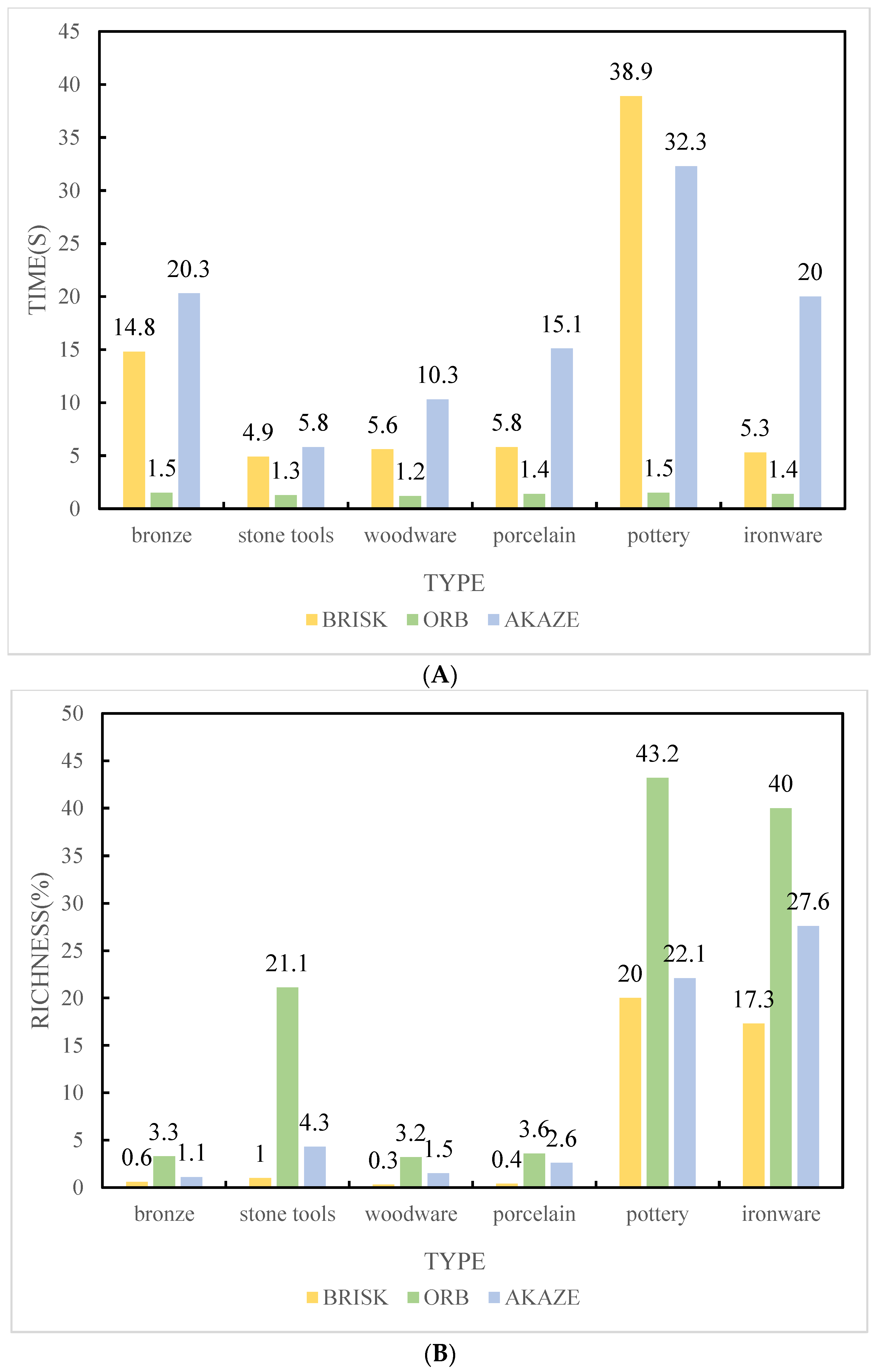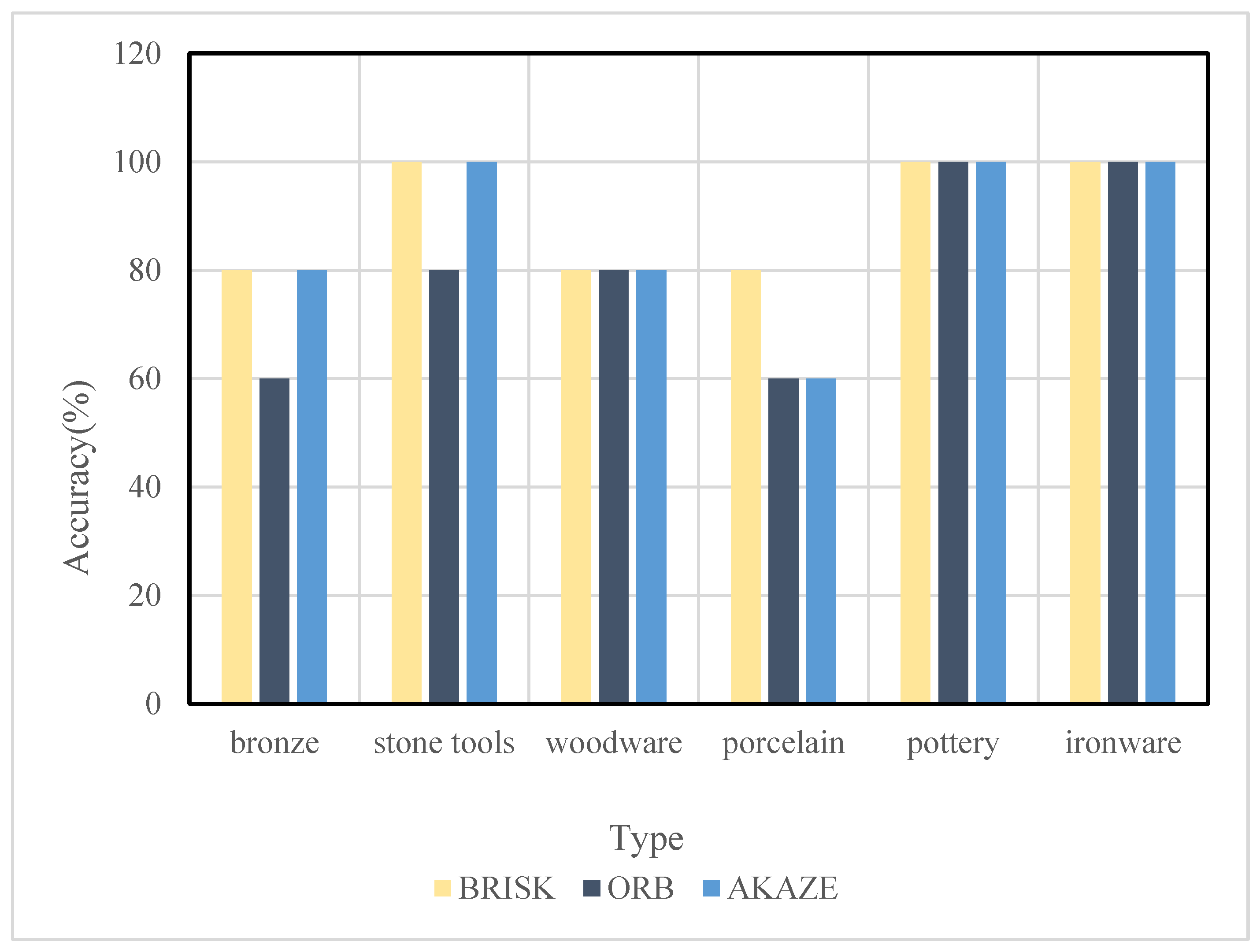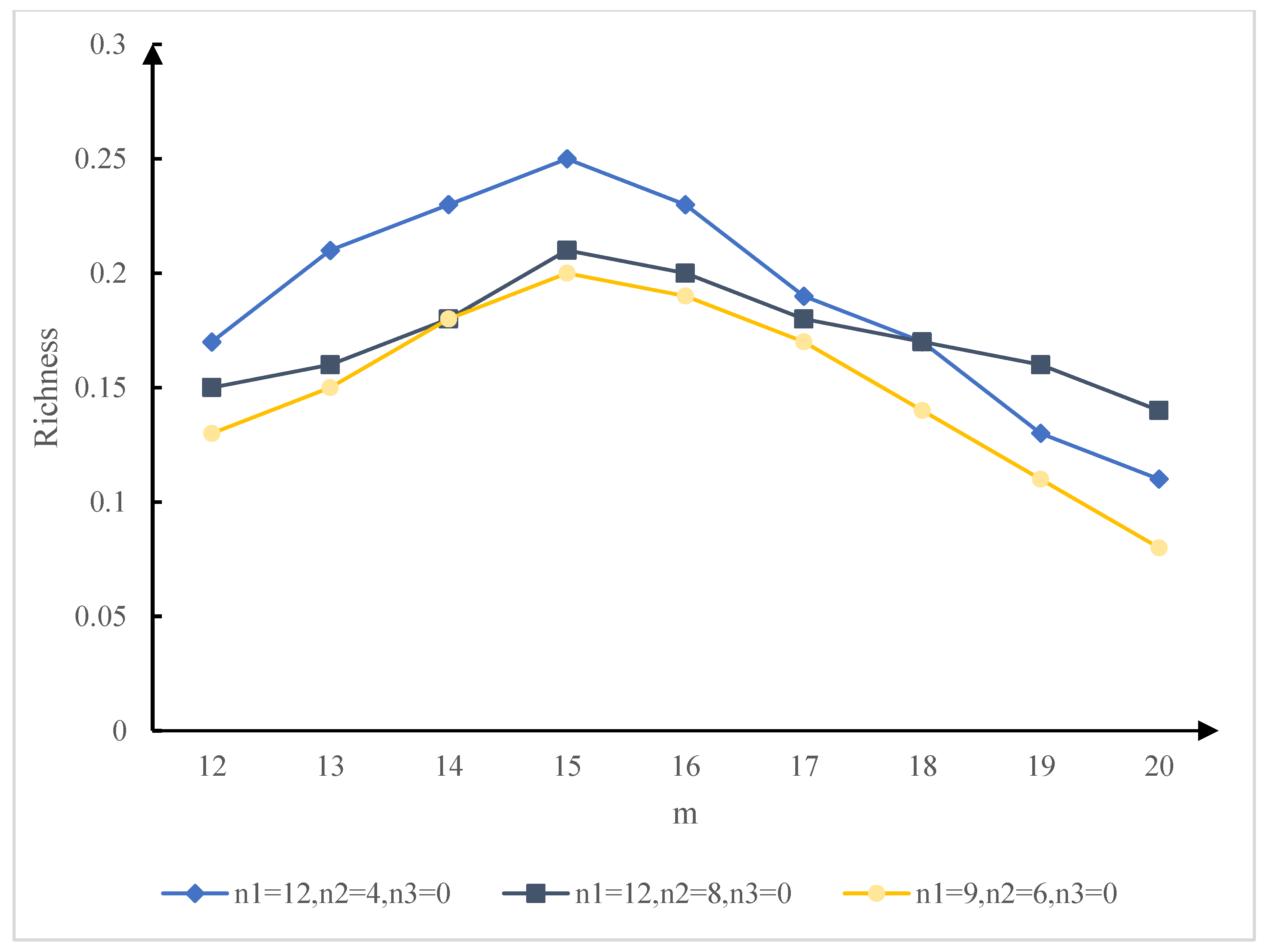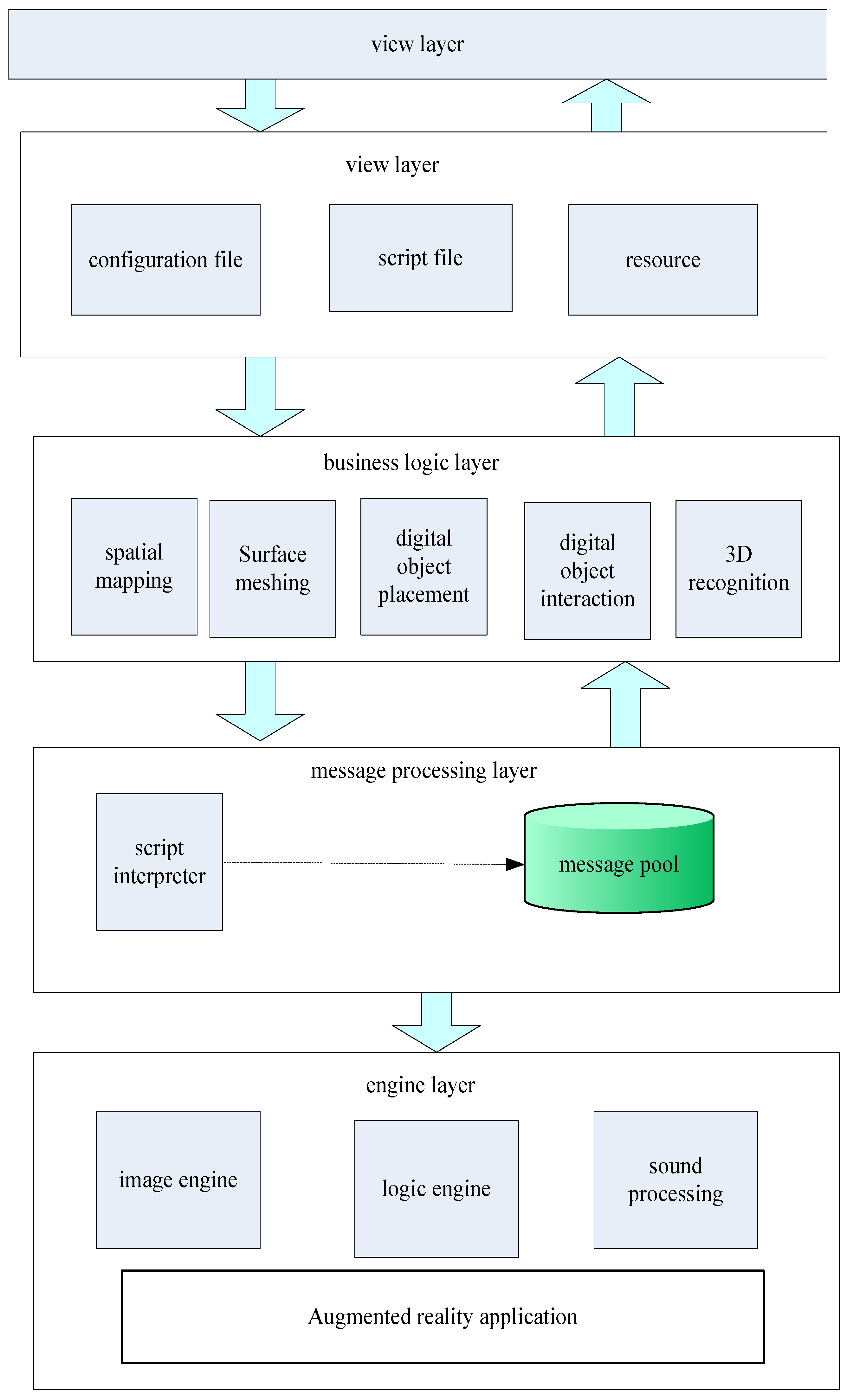Application of Optimized ORB Algorithm in Design AR Augmented Reality Technology Based on Visualization
Abstract
1. Introduction
2. AR and Digital Art Media
2.1. Digital Art Media
2.2. Digital Image Recognition Algorithms
2.2.1. BRISK Algorithm
2.2.2. ORB Algorithm
2.2.3. AKAZE Algorithm
3. Improved ORB Algorithm
4. Overall Design of the Augmented Reality Digital Museum System
4.1. Overall System Architecture Design
4.2. System Function Module Design
4.3. System 3D Model Design
4.4. System Testing and Experience Evaluation
4.4.1. The Function of a Digital Museum Based on Spatial Mapping
4.4.2. Recognition Function Based on Vuforia3D
4.4.3. User Experience Evaluation
5. Conclusions
Author Contributions
Funding
Data Availability Statement
Conflicts of Interest
References
- Song, S.; Sun, G. Digital Media Art Communication Based on Wireless Cooperative Routing with Minimum Energy Consumption. J. Sens. 2021, 2021 Pt 11, 6800470. [Google Scholar] [CrossRef]
- Zhu, T. The Reform of Digital Media Art Professional Curriculum System Based on Internet Technology. J. Phys. Conf. Ser. 2021, 1992, 032121–032125. [Google Scholar] [CrossRef]
- Zinman, G. Nam June Paik’s Etude 1 and the Indeterminate origins of Digital Media Art. October 2018, 164, 3–28. [Google Scholar] [CrossRef]
- Sayre, L. The Art of Hip-Hop in Digital Media. Writ. Waves 2019, 1, 17. [Google Scholar]
- Hernandez, S. Case study: Digitising Cleveland Museum of Art history one negative at a time. J. Digit. Media Manag. 2018, 6, 327–338. [Google Scholar]
- Erwinsah, R.; Aria, M.; Yusup, Y. Application of augmented reality technology in biological learning. J. Phys. Conf. Ser. 2019, 1402, 066090. [Google Scholar] [CrossRef]
- Almquist, E.G. Augmented Reality. Iron Steel Technol. 2022, 19, 38–41. [Google Scholar]
- Gao, X.; Hui, A.; Chen, W.; Pan, Z.; Amp, D.M. A Survey on Mobile Augmented Reality Visualization. Jisuanji Fuzhu Sheji Yu Tuxingxue Xuebao/J. Comput. Aided Des. Comput. Graph. 2018, 30, 1–9. [Google Scholar] [CrossRef]
- Qiu, C.; Zhou, S.; Liu, Z.; Gao, Q.; Tan, J. Digital assembly technology based on augmented reality and digital twins: A review. Virtual Real. Smart Hardw. 2019, 1, 597–610. [Google Scholar] [CrossRef]
- Wang, S.; Kaikai, D.U.; Song, N.; Zhao, D.; Feng, D.; Tu, Z. Study on the adaptability of augmented reality smartglasses for astigmatism based on holographic waveguide grating. Virtual Real. Smart Hardw. 2020, 2, 79–85. [Google Scholar] [CrossRef]
- Bakri, F.; Pratiwi, S.; Muliyati, D. Student worksheet with augmented reality technology: Media to construct higher order thinking skills of high school students in elasticity topic. J. Phys. Conf. Ser. 2020, 1521, 022033. [Google Scholar] [CrossRef]
- Hutahaean, H.D.; Rahman, S.; Mendoza, M.D. Development of interactive learning media in computer network using augmented reality technology. J. Phys. Conf. Ser. 2022, 2193, 012072. [Google Scholar] [CrossRef]
- Sucihati, R.; Malyan, A.; Cofriyanti, E. Augmented Reality in the Registration Flow for Enterance Eximination at State Polytechnic of Sriwijaya Based on Android. J. Phys. Conf. Ser. 2020, 1500, 012128. [Google Scholar] [CrossRef]
- Wilujeng, S.; Chamidah, D.; Wahyuningtyas, E. Learning development model biological material “flowers wijaya kusuma (Epiphyllum anguliger)” by using augmented reality media to facilitate independent learning students. IOP Conf. Ser. Mater. Sci. Eng. 2018, 434, 012101. [Google Scholar] [CrossRef]
- Yussof, F.M.; Salleh, S.M.; Ahmad, A.L. Factors of augmented reality technology adoption in influencing attitude and purchasing intention: A review on advertising context. Int. J. Adv. Sci. Technol. 2019, 28, 321–328. [Google Scholar]
- Linse, C.; Alshazly, H.; Martinetz, T. A walk in the black-box: 3D visualization of large neural networks in virtual reality. Neural Comput. Appl. 2022, 34, 21237–21252. [Google Scholar] [CrossRef]
- Liono, R.A.; Amanda, N.; Pratiwi, A.; Gunawan, A. A Systematic Literature Review: Learning with Visual by The Help of Augmented Reality Helps Students Learn Better. Procedia Comput. Sci. 2021, 179, 144–152. [Google Scholar] [CrossRef]
- Dubey, V. FinTech Innovations in Digital Banking. Int. J. Eng. Technol. Res. 2019, 8, 597–610. [Google Scholar]
- Mager, A.; Katzenbach, C.; Liao, T.; Iliadis, A. A future so close: Mapping 10 years of promises and futures across the augmented reality development cycle. New Media Soc. 2021, 23, 258–283. [Google Scholar]
- Ignatyev, V.I. Ontology of Augmented Reality. Discourse 2020, 6, 80–96. [Google Scholar] [CrossRef]
- Jun, G. Virtual Reality Church as a New Mission Frontier in the Metaverse: Exploring Theological Controversies and Missional Potential of Virtual Reality Church. Transform. Int. J. Holist. Mission Stud. 2020, 37, 297–305. [Google Scholar] [CrossRef]
- Lindner, C.; Rienow, A.; Juergens, C. Augmented Reality applications as digital experiments for education—An example in the Earth-Moon System. Acta Astronaut. 2019, 161, 66–74. [Google Scholar] [CrossRef]
- Makowski, M.; Pitek, P.; Grynkiewicz, M. Projection of holographic images in volumetric fluorescent fluids for near-eye displays. Photon. Lett. Pol. 2019, 11, 99–103. [Google Scholar] [CrossRef]
- Zheng, X.; Kamruzzaman, M.M.; Shi, J. Method of generating face image based on text description of generating adversarial network. J. Electron. Imaging 2022, 31, 051411. [Google Scholar]
- Nurhasanah, Y.; Putri, D.A. Pengembangan Media Pembelajaran Digital Berbasis Augmented Reality Pada Topik Klasifikasi Hewan Berdasarkan Habitatnya. Multinetics 2020, 6, 86–98. [Google Scholar] [CrossRef]
- Mikolajczyk, K.; Schmid, C. A performance evaluation of local descriptors. IEEE Trans. Pattern Anal. Mach. Intell. 2005, 27, 1615–1630. [Google Scholar] [CrossRef]
- Bojanić, D.; Bartol, K.; Pribanić, T.; Petković, T.; Donoso, Y.D.; Mas, J.S. On the Comparison of Classic and Deep Keypoint Detector and Descriptor Methods. In Proceedings of the 2019 11th International Symposium on Image and Signal Processing and Analysis (ISPA), Dubrovnik, Croatia, 23–25 September 2019; pp. 64–69. [Google Scholar] [CrossRef]







| Functional Module | Serial Number | The Construction of a Digital Museum Based on Spatial Mapping |
|---|---|---|
| Test Conditions | 1 | The tester wears Holoens in a relatively empty indoor environment. |
| 2 | The indoor environment requires walls, floors, and ceilings. | |
| 3 | The indoor environment is relatively bright, without pure black large surfaces and reflective surfaces. | |
| 4 | The tester starts the spatial mapping scan thread. | |
| Use case steps | 1 | Tester turns on space mapping. |
| 2 | The tester walks slowly in the environment, moving and scanning walls, floors, and ceilings. | |
| 3 | Scan time expires; testers can view digital artifacts. | |
| Expected outcome | 1 | The scan time is 10 s, and the tester can see the generated surface mesh. |
| 2 | When the scan time expires, the scene intelligently generates a museum scene, and there are cultural relics on the ground and walls. | |
| 3 | The cultural relics on the wall and the ground are more suitable for the tester, which is about 2 m away. | |
| Actual results | 1 | The spatial scanning function is normal, and the meshing processing and plane generation are as expected. |
| 2 | Flat map as expected. | |
| 3 | The artifacts that are intelligently generated on the wall are on the largest wall closest to the user. | |
| 4 | The artifacts generated intelligently on the ground are on the largest ground closest to the user. |
| Functional Module | Serial Number | 3D Recognition of Real Cultural Relics Based on Vuforia |
|---|---|---|
| Test conditions | 1 | Test object: real cultural relics with feature point scanning and project configuration in advance. |
| 2 | The tester wears Holoens and stands in front of the configured Pixiu. | |
| 3 | Start the AR (augmented reality) recognition thread. | |
| Use case steps | 1 | Testers wear Hololens to open the AR cultural relic identification thread. |
| 2 | Annotated cultural relics Pixiu. | |
| 3 | Pixiu body. Gaze cursor feedback appears on the body, and testers can click. | |
| Expected results | 1 | If the recognition is successful, the cursor feedback will appear on the Pixiu, which can be clicked with gestures. |
| Actual results | 1 | The recognition is normal, the cursor feedback appears on the Pixiu, and the gesture-click interaction is possible. |
| 2 | The tester needs to continuously annotate the cultural relics (5 m) at a close distance (less than 0.5 m) in order to succeed. |
| Evaluation Parameters | Highest Score | Lowest Score | Average |
|---|---|---|---|
| Innovation | 10 | 6 | 9.3 |
| Ease of use | 8 | 4 | 7.6 |
| Interactivity | 10 | 8 | 8.7 |
| Performance operation | 8.5 | 6 | 7.9 |
| Functionality | 9.5 | 7 | 8.6 |
| Stimulate interest | 10 | 8 | 9.3 |
| Satisfaction | 10 | 6 | 8.2 |
Disclaimer/Publisher’s Note: The statements, opinions and data contained in all publications are solely those of the individual author(s) and contributor(s) and not of MDPI and/or the editor(s). MDPI and/or the editor(s) disclaim responsibility for any injury to people or property resulting from any ideas, methods, instructions or products referred to in the content. |
© 2023 by the authors. Licensee MDPI, Basel, Switzerland. This article is an open access article distributed under the terms and conditions of the Creative Commons Attribution (CC BY) license (https://creativecommons.org/licenses/by/4.0/).
Share and Cite
Yan, H.; Wang, J.; Zhang, P. Application of Optimized ORB Algorithm in Design AR Augmented Reality Technology Based on Visualization. Mathematics 2023, 11, 1278. https://doi.org/10.3390/math11061278
Yan H, Wang J, Zhang P. Application of Optimized ORB Algorithm in Design AR Augmented Reality Technology Based on Visualization. Mathematics. 2023; 11(6):1278. https://doi.org/10.3390/math11061278
Chicago/Turabian StyleYan, Hai’an, Jian Wang, and Peng Zhang. 2023. "Application of Optimized ORB Algorithm in Design AR Augmented Reality Technology Based on Visualization" Mathematics 11, no. 6: 1278. https://doi.org/10.3390/math11061278
APA StyleYan, H., Wang, J., & Zhang, P. (2023). Application of Optimized ORB Algorithm in Design AR Augmented Reality Technology Based on Visualization. Mathematics, 11(6), 1278. https://doi.org/10.3390/math11061278




